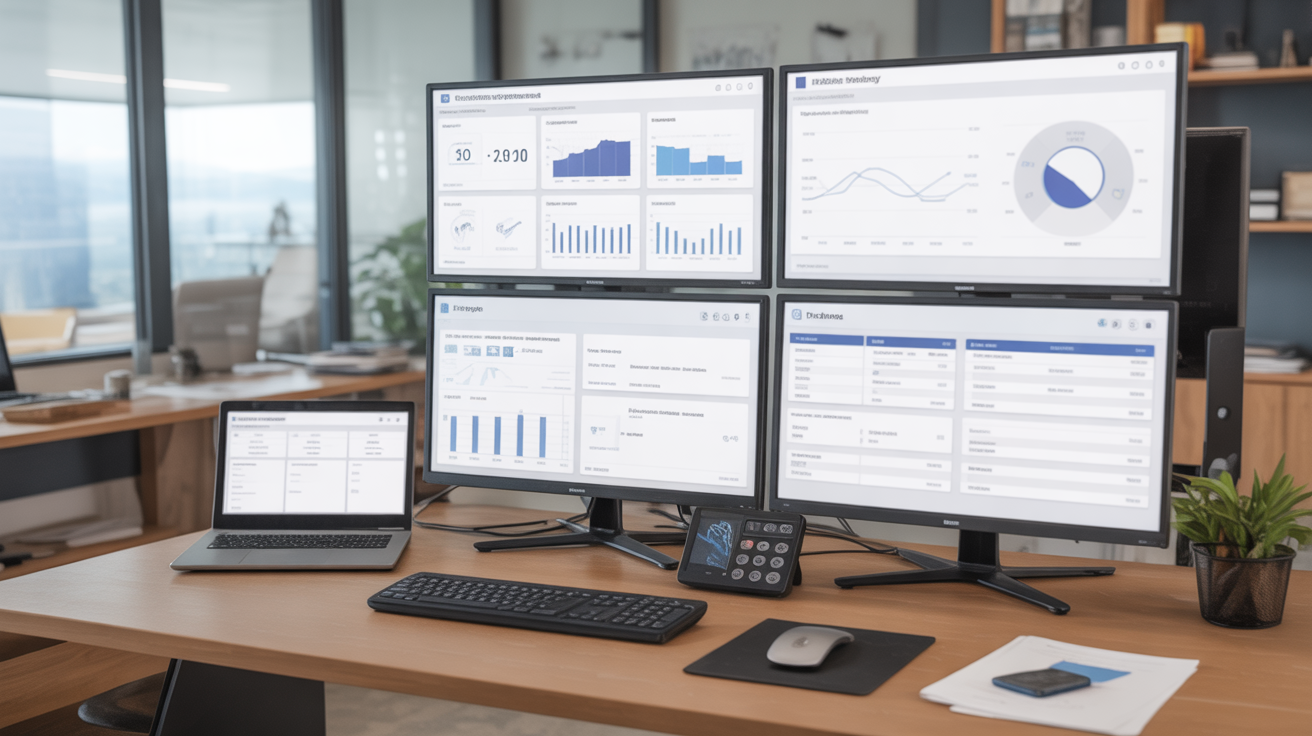Contractor Marketing ROI: How to Track Leads and Measure Success
Here's the Question Every Contractor Should Ask (But Most Don't)
"Is my marketing actually making me money, or am I just spending money and hoping for the best?"
If you can't answer that question with specific numbers, you're not alone. Most contractors treat marketing like a donation - they spend money on websites, ads, and SEO, then cross their fingers and hope the phone rings more often.
I'm Mike from Purple Wave Creative, and I've been helping contractors solve this exact problem for years. The construction companies that dominate their markets don't just do good marketing - they measure their marketing to make sure every dollar spent brings back more dollars in projects.
Here's what I've learned: contractors who track their marketing ROI properly grow faster, waste less money, and build more sustainable businesses than contractors who guess about what's working.
This isn't theoretical marketing analytics or complicated formulas you'll never use. This is a practical system for construction companies who want to know exactly which marketing activities are filling their project pipeline and which ones are wasting their money.
Because here's the reality - if you can't measure it, you can't improve it. And if you can't improve it, your competitors who can measure and optimize their marketing will eventually capture the customers who should be choosing you.
Why Most Contractor Marketing ROI Tracking Fails
Most contractors fail at measuring marketing ROI because they approach it like a side project instead of a critical business function that directly impacts profitability.
The Common Contractor ROI Mistakes
The "Spray and Pray" Approach: Spending money on multiple marketing activities without tracking which ones generate leads, estimates, or actual projects.
Vanity Metric Obsession: Focusing on website visitors, social media followers, or email open rates instead of measuring actual business impact like project inquiries and contract signings.
Attribution Confusion: Not knowing whether leads came from SEO, Google Ads, referrals, or repeat customers, making it impossible to optimize marketing spending.
Time Lag Ignorance: Expecting immediate results from long-term strategies like SEO, or not accounting for the fact that construction projects often have long sales cycles.
Tool Overload: Using too many complicated analytics tools without connecting them to actual business outcomes that matter to construction companies.
Why This Costs You Money
Wasted Marketing Spend: Without ROI tracking, you might be spending thousands on marketing tactics that generate zero projects while underfunding strategies that actually work.
Missed Opportunities: When you don't know which marketing generates your best customers, you miss opportunities to scale successful approaches.
Competitive Disadvantage: While you're guessing about marketing effectiveness, competitors who track ROI are optimizing their strategies and capturing more market share.
Cash Flow Problems: Poor marketing ROI tracking leads to inconsistent lead generation, creating feast-or-famine business cycles.
The Contractor ROI Success Formula
Lead Tracking + Source Attribution + Project Value Analysis + Cost Analysis = Clear ROI Understanding
You need to know where your leads come from, which leads convert to projects, what those projects are worth, and how much you spent to generate them.
Want to see examples of contractors who transformed their businesses by implementing proper ROI tracking? Follow our Instagram where we share real ROI case studies and measurement systems that work for construction companies.
Setting Up Lead Tracking Systems That Actually Work
Effective lead tracking for contractors requires systems that capture where leads come from, how they progress through your sales process, and which ones convert to profitable projects.
Essential Lead Tracking Components
Lead Source Identification: Every inquiry needs to be tagged with its source:
Website contact forms (specify which page)
Google My Business profile clicks and calls
Phone calls (use tracking numbers for different marketing channels)
Referrals (existing customers, partners, suppliers)
Direct mail, advertising, or other paid marketing
Lead Quality Assessment: Not all leads are created equal. Track:
Project type and estimated value
Timeline (immediate, planning phase, future)
Geographic location within service area
Budget range and decision-making authority
Competition level and probability of winning
Conversion Stage Tracking: Monitor leads through your sales process:
Initial inquiry received
Estimate requested and scheduled
Proposal delivered
Contract negotiated and signed
Project completed and payment received
Simple Contractor CRM Systems
Spreadsheet-Based Tracking (For smaller contractors):
Lead source, contact information, project details
Inquiry date, estimate date, proposal date, contract date
Project value, profit margin, completion status
Marketing source and cost attribution
CRM Software Solutions (For growing contractors):
BuilderTREND, CoConstruct, or Contractor Foreman
HubSpot or Salesforce for more comprehensive tracking
Integration with website forms and phone systems
Automated lead nurturing and follow-up systems
Phone Call Tracking
Dedicated Phone Numbers: Use different phone numbers for different marketing channels:
Website contact number
Google My Business listing number
Print advertising number
Vehicle signage number
Emergency service number
Call Tracking Software:
CallRail, CallTrackingMetrics, or similar services
Record calls for quality control and training
Track call duration, outcomes, and conversion rates
Integration with CRM systems for complete lead attribution
For advanced lead tracking strategies that integrate with contractor business operations, connect with us on LinkedIn where we share detailed measurement systems and ROI optimization techniques.
Measuring Marketing Channel Performance
Different marketing channels work differently for contractors, and measuring each channel's performance helps you allocate budget to the most effective strategies.
SEO and Website Performance Tracking
Organic Search Metrics That Matter:
Local search ranking positions for key contractor terms
Website traffic from organic search
Contact form submissions from organic visitors
Phone calls from website visitors
Geographic distribution of organic traffic
Website Conversion Tracking:
Pages visited before contact (service pages, project galleries)
Time spent on site before inquiry
Mobile vs. desktop conversion rates
Contact form completion rates by traffic source
Emergency service contact patterns
Local SEO Performance:
Google My Business profile views and interactions
Direction requests and phone calls from GMB
Review generation and rating improvements
Local search visibility and map pack appearances
Paid Advertising ROI Analysis
Google Ads Performance:
Cost per click and cost per lead
Conversion rates from ads to inquiries
Quality score and ad relevance metrics
Geographic performance by service area
Keyword performance and search term analysis
Facebook and Social Media Advertising:
Reach and engagement metrics
Lead generation form completions
Cost per lead and lead quality assessment
Audience targeting effectiveness
Creative performance and ad optimization
Traditional Marketing Measurement
Print and Direct Mail Tracking:
Dedicated phone numbers and landing pages
Promotional codes for tracking responses
Geographic targeting effectiveness
Cost per response and conversion rates
Brand awareness and recall metrics
Vehicle and Signage Marketing:
Branded vehicle visibility and recognition
Yard sign and job site signage effectiveness
Word-of-mouth referrals from visibility marketing
Community brand recognition and reputation building
Customer Lifetime Value Analysis for Contractors
For contractors, customer lifetime value (CLV) is critical because satisfied customers often provide repeat business, referrals, and long-term relationships that significantly exceed initial project values.
Calculating Contractor Customer Lifetime Value
Basic CLV Formula for Contractors: Average Project Value × Number of Projects per Customer × Referrals Generated = Customer Lifetime Value
Enhanced CLV Calculation:
Initial project value and profit margin
Repeat business probability and frequency
Average referral generation per satisfied customer
Maintenance and service call revenue
Upsell opportunities and additional services
CLV by Customer Type:
Residential customers (renovations, maintenance, referrals)
Commercial customers (repeat projects, maintenance contracts)
Property developers (multiple projects, ongoing relationships)
Municipal clients (repeat bid opportunities, long-term contracts)
Repeat Business Tracking
Customer Retention Analysis:
Percentage of customers who hire you for additional projects
Time between initial project and repeat business
Average value increase for repeat customers
Reasons customers choose competitors for subsequent projects
Maintenance and Service Revenue:
Annual maintenance contract values
Emergency service call frequency and value
Seasonal service patterns and revenue
Equipment replacement and upgrade opportunities
Referral Value Measurement
Referral Generation Tracking:
Number of referrals per satisfied customer
Conversion rate of referrals to projects
Average project value from referral customers
Multi-generation referral tracking (referrals who refer others)
Referral Source Analysis:
Which project types generate the most referrals
Customer satisfaction factors that drive referrals
Geographic patterns in referral generation
Industry or customer type that refers most frequently
Connect with other contractors sharing customer value optimization strategies on our Facebook page where we discuss long-term business relationship building and customer retention techniques.
Cost Per Lead and Project Value Analysis
Understanding the true cost of acquiring customers and the value they bring helps contractors make smart decisions about marketing investment and budget allocation.
Cost Per Lead Calculation
Direct Marketing Costs:
Website design and maintenance costs
SEO services and optimization expenses
Google Ads and paid advertising spending
Print advertising and direct mail costs
Trade show and networking event expenses
Time Investment Costs:
Your time spent on marketing activities (valued at your hourly rate)
Staff time for marketing tasks and lead follow-up
Content creation and social media management time
Networking and relationship building time
Lead Generation Analysis:
Total marketing investment per month/quarter/year
Number of leads generated in same period
Cost per lead by marketing channel
Lead quality scores and conversion potential
Geographic distribution and service area effectiveness
Project Value and Profitability Analysis
Project Profitability Breakdown:
Gross project revenue
Material costs and subcontractor expenses
Labor costs and project management time
Overhead allocation and business expenses
Net profit per project and profit margin percentage
Marketing ROI Calculation:
Total marketing cost to acquire customer
Customer lifetime value (initial project + repeat business + referrals)
Payback period (time to recover marketing investment)
Return on marketing investment (ROMI) percentage
Contribution margin and business growth impact
Channel-Specific ROI Analysis
SEO and Organic Search ROI:
Monthly SEO investment costs
Organic leads generated and conversion rates
Average project value from organic leads
Long-term SEO value and compounding returns
Local market domination and competitive advantage
Paid Advertising ROI:
Ad spend and management costs
Immediate lead generation and conversion rates
Customer acquisition cost vs. customer lifetime value
Scalability and budget optimization opportunities
Geographic and demographic targeting effectiveness
Seasonal Tracking and Business Cycle Analysis
Construction businesses have natural seasonal patterns, and effective ROI tracking accounts for these cycles to optimize marketing timing and budget allocation.
Seasonal Performance Patterns
Construction Season Analysis:
Winter: Planning, indoor projects, emergency services
Spring: Project startup, outdoor work preparation, marketing push
Summer: Peak construction season, project execution focus
Fall: Project completion, winter preparation, planning for next year
Marketing Effectiveness by Season:
Lead generation patterns throughout the year
Conversion rates during different seasons
Project value variations by time of year
Customer behavior and decision-making cycles
Budget Allocation Optimization
Seasonal Marketing Investment:
Higher marketing spend during planning seasons (winter/early spring)
Maintenance marketing during peak construction season
Relationship building and referral focus during busy periods
Strategic planning and optimization during slower seasons
ROI Analysis by Season:
Cost per lead variations throughout the year
Customer lifetime value by acquisition season
Marketing channel effectiveness during different periods
Long-term business growth and capacity planning
Business Cycle Planning
Annual ROI Planning:
Set annual marketing budget based on ROI targets
Allocate spending based on seasonal effectiveness
Plan for business growth and capacity expansion
Adjust strategies based on market conditions and competition
Multi-Year Trend Analysis:
Year-over-year ROI improvement tracking
Market share growth and competitive positioning
Business development and strategic planning
Investment in long-term marketing assets (SEO, brand building)
Tools and Systems for Contractor ROI Tracking
Effective ROI tracking requires the right combination of tools that work together to provide clear visibility into marketing performance and business impact.
Essential ROI Tracking Tools
Google Analytics and Search Console:
Website traffic sources and conversion tracking
Lead generation form submissions and phone calls
Local search performance and keyword rankings
User behavior analysis and conversion path tracking
Mobile performance and emergency service access patterns
CRM and Lead Management:
Customer relationship management systems
Lead tracking from inquiry to project completion
Project value and profitability analysis
Customer communication and follow-up automation
Referral tracking and relationship management
Financial Integration:
QuickBooks or accounting software integration
Project profitability and cost analysis
Cash flow tracking and business financial health
Tax preparation and business expense management
Investment analysis and budget planning
Contractor-Specific Tracking Solutions
Construction Management Software:
BuilderTREND, CoConstruct, or Contractor Foreman
Project management and customer communication
Estimate and proposal tracking
Change order management and profitability analysis
Warranty and follow-up service tracking
Call Tracking and Communication:
CallRail or CallTrackingMetrics for phone attribution
Text messaging and communication tracking
Voicemail transcription and lead qualification
Emergency service response time tracking
Customer satisfaction and service quality monitoring
Reporting and Dashboard Setup
Executive Dashboard Development:
Key performance indicators (KPIs) for contractor businesses
Real-time ROI tracking and trend analysis
Marketing channel performance comparison
Lead generation and conversion metrics
Financial performance and business growth indicators
Monthly ROI Reporting:
Marketing investment vs. business results
Lead generation and project pipeline analysis
Customer acquisition costs and lifetime value
Market share and competitive positioning
Strategic recommendations and optimization opportunities
Making Data-Driven Marketing Decisions
The ultimate goal of ROI tracking is using data to make smarter marketing decisions that grow your construction business more efficiently and profitably.
ROI-Based Budget Allocation
High-Performing Channel Investment: When data shows certain marketing channels consistently deliver strong ROI:
Increase budget allocation to successful strategies
Scale winning approaches to capture more market share
Optimize high-performing channels for even better results
Test expansion into related or similar marketing opportunities
Low-Performing Channel Optimization: When channels underperform:
Analyze why performance is poor (targeting, messaging, execution)
Test improvements before eliminating channels entirely
Reallocate budget to higher-performing alternatives
Document lessons learned for future strategy development
Strategic Business Planning
Growth Planning Based on ROI Data:
Capacity planning based on marketing-driven lead generation
Geographic expansion into markets with strong ROI potential
Service expansion based on customer demand and profitability
Team growth and hiring based on sustainable business development
Competitive Strategy Development:
Market positioning based on ROI analysis and customer feedback
Competitive advantage development through data-driven insights
Pricing strategy optimization based on customer value analysis
Brand building investment based on long-term ROI projections
Continuous Optimization Process
Monthly ROI Reviews:
Analyze performance against goals and benchmarks
Identify trends and opportunities for improvement
Adjust tactics based on performance data
Plan next month's marketing activities and budget allocation
Quarterly Strategic Planning:
Comprehensive ROI analysis and business impact assessment
Strategic adjustments based on market conditions and performance
Budget reallocation and investment optimization
Long-term planning and capacity development
The Purple Wave Creative ROI Advantage
At Purple Wave Creative, we understand that contractor marketing isn't about impressive reports or vanity metrics - it's about generating measurable business growth and profitable project leads.
Our Contractor ROI Expertise
Construction Industry Focus: We work specifically with contractors and understand:
Project-based business models and long sales cycles
Seasonal patterns and capacity planning challenges
Customer lifetime value including repeat business and referrals
Local market dynamics and competitive positioning
Comprehensive ROI Tracking: Our approach includes:
Lead tracking systems integrated with business operations
Multi-channel attribution and performance analysis
Customer lifetime value calculation and optimization
Financial integration and profitability analysis
Strategic planning based on data-driven insights
Results-Focused Partnership: We measure our success by your business growth:
Clear ROI reporting and performance accountability
Strategic recommendations based on data analysis
Continuous optimization and improvement processes
Transparent communication about marketing effectiveness
What Makes Our ROI Approach Different
Business Integration:
ROI tracking systems that integrate with contractor business operations
Financial analysis that considers construction industry profit margins
Seasonal planning and capacity optimization
Long-term relationship building and customer value maximization
Practical Implementation:
Simple, usable systems that don't require extensive training
Clear reporting that focuses on business impact
Strategic guidance based on construction industry experience
Ongoing support and optimization partnership
Transparent Accountability:
Clear measurement of our impact on your business growth
Regular ROI reporting and performance analysis
Strategic recommendations for continuous improvement
Honest assessment of what's working and what needs adjustment
Your ROI Tracking Action Plan
The contractors who build the most successful businesses don't just do great work - they measure their marketing to ensure every dollar invested brings back multiple dollars in projects and business growth.
Your construction expertise and project quality are what satisfy customers, but ROI tracking is what ensures your marketing investment creates sustainable business growth and competitive advantage.
Ready to master contractor marketing ROI? Here's what to read next:
SEO for Construction Companies: The Complete Digital Marketing Guide - Comprehensive SEO strategies with built-in measurement systems for tracking ROI and optimizing performance.
Contractor Website Design: SEO Best Practices for Construction Companies - Website design that includes conversion tracking and lead generation measurement for clear ROI visibility.
HVAC Contractor Marketing: SEO, Social Media & Lead Generation Strategy - Specialized marketing approaches with seasonal ROI tracking and performance optimization.
Ready to start measuring your contractor marketing ROI properly? Let's implement tracking systems that show exactly which marketing activities are growing your construction business and which ones are wasting your money. Schedule your ROI tracking consultation and let's build measurement systems that optimize your marketing investment for maximum business growth.










